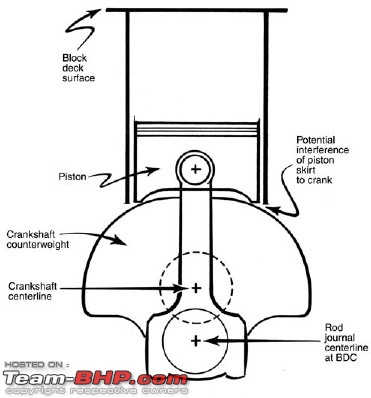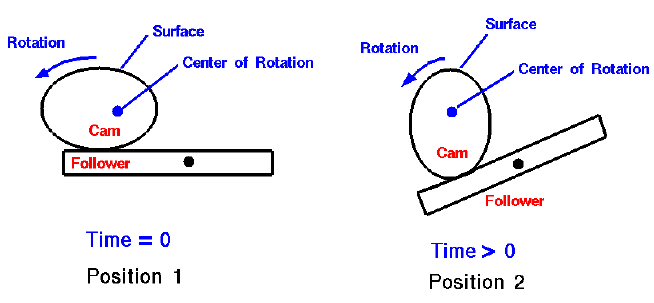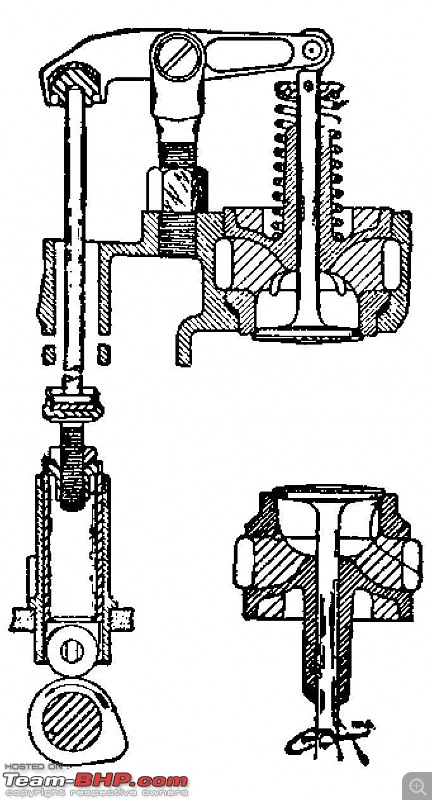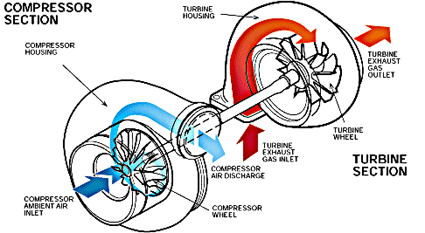| |||||||
| Search Forums |
| Advanced Search |
| Go to Page... |
 |
| Search this Thread |  10,138 views |
| | #1 |
| Senior - BHPian Join Date: Jun 2015 Location: Chicago
Posts: 3,002
Thanked: 6,921 Times
| Know what's under your hood - The ABCs of an engine I'm just want to write a basic article on engines and air intake systems. Engine: Engine is the heart of your automobile. Whether it's your 100cc bike or your huge SUV, it's the engine's power that's used to drive the wheels. In all automobiles, the transmission system consisting of gears (or a belt and pulleys for a CVT) This transmission of power varies in trains and ships where a diesel engine is used to drive electric motors to propel the wheels/propeller. Here's an engine(minus the cover):  The combustion of fuel in the cylinder of an engine forces the piston downwards. This downward motion is converted to rotation of the crankshaft by the connecting rod. At the lowest point, the engine comes up due to the rotation of crankshaft by other pistons(in a multicylinder engine, remember "firing order" which I'll explain later ) and also due to inertial effects.  What's the displacement of your engine? How does the manufacturer claim that your engine is a 1.6 L or a 2.4 L? Well the answer lies in the bore and stroke of the engine and the number of cylinders.   The bore is a diameter of the cylinder of your engine. The stroke is the distance travelled between Top dead centre(TDC) to the Bottom dead centre(BDC) In a single cylider, the displacement is the volume of the cylinder covered by the piston moving from TDC to BDC. For a multicylinder engine, multiply the value by the number of cylinders. Square engine: Is an engine in which bore=stroke. It's not a very common configuration in engines. Eg: Innova petrol (2.0) Undersquare engine: Is an engine which has (bore/stroke<1). Mostly used in petrol engines and high performance cars. Very few diesels are undersquare. This configuration allows for higher power and has lower torque. Oversquare engine: Is an engine which has (bore/stroke>1). Mostly used in diesel engines and petrol engine which are required to produce high torque. This configuration allows for higher torque and has lower power. Calculating Displacement: Note: "pi" is a mathematical constant which is the ratio of the diameter of a circle to it's radius. The closest approximation is 22/7 or 355/113. It is often taken as 3.14 Example: For a KTM 390, the bore is 89 mm (=8.9 cm) and the Stroke is 60 mm(=6 cm). Volume: (pi*bore*bore*stroke)/4. That gives you 373.268 cc. That's slightly away from the figure 390, but all manufacturers do this. (Maruti's 1.3 JTD is actually a 1248 cc Diesel  ) )For the engine of the Toyota 86 and Innova Petrol, the Bore and Stroke is 86 mm. The similarities end there, they are two different engine configurations. Volume : (pi*bore*bore*stroke*no of cylinder)/4. That is 1998.228 cc, not far from the claimed 2.0 L. Firing order: Firing order is the order in which the Fuel in the engine is ignited, i.e. it's in the working stroke. Firing order is decided by the designers to minimise vibrations, ensure smooth running and extended engine life by eliminating unnecessary stresses. For a three cylinder engine: the firing order is 1-3-2. In some engines, it's also 1-2-3.(Rare case) For a four cylinder engine: 1-3-4-2 is the most common firing order. Others are 1-2-4-3, 1-3-2-4 and 1-4-3-2. For a six cylinder engine: The firing order is 1-5-3-6-2-4 for most I6s. For V6s, it's generally 1-5-6-4-3-2. There are many permutations for 6 cylinder engines, but the above listed ones are the most common. Camshaft and Valvetrain: One of the most important parts of your engine, which controls the inlet of air and outlet of exhaust gas. The poppet valves become a very important part of your engine as they seal your combustion chamber (Making it an "Internal Combustion" engine) Camshafts are driven by a timing chain/belt connected to you crankshaft. Here's a cam:  Here's the complete valve train along with spring loaded valves:  So what does 16V DOHC mean? What does 12V SOHC mean? An engine cylinder typically has 4 valves(2 intake+ 2 exhaust) in the cylinder head. Some have three(2 intake+ 1 exhaust; Eg-Hyundai Getz 1.3) and some have two(1 intake+ 1 exhaust; Eg-Renault K9K). A 16 V DOHC means that the engine has 16 valves- 4 valves each for 4 cylinders. DOHC stands for "dual overhead camshaft." There are two different camshafts for intake and exhaust valves. A 8 V SOHC means that there 8 valves- 2 valves each for the 4 cylinders. SOHC stands for "single overhead camshaft." There is a single camshaft for intake and exhaust valves. Piston rings: Piston rings are used to:
Here's a set of piston rings:  Naturally Aspirated [N/A] engines: N/A engines are the oldest types, but are far from dead. Almost all petrol cars(mass-produced) have N/A motors. They just suck in air due to the vacuum created by the engine in the suction stroke. They are less powerful compared to turbocharged engines, but cheaper to manufacture and repair. Advancements like Variable valve timing and Atkinson cycle have given a new lease of life to N/A engines, but looks like they will disappear in the near future. Reasons why petrol cars still survive as naturally aspirated:
Reasons 2 and 3 are not exactly true now, because VW, Ford, Hyundai and many other companies are making Tubro petrol engines. It was the reason a decade ago. Turbocharging: Turbocharging is the easiest way to extract more power from an engine. It consists of a turbine and compressor mounted on a single shaft. The turbine is run by the pressure of the exhaust gasses, driving the compressor to pressurise the intake air and send a greater volume of air into the engine. For a turbo charged engine, the engine parts(engine block, piston, connecting rod, crankshaft) have to have high strength to bear the pressure exerted by the Turbocharger/Supercharger. Here's a turbocharger:  NOTE: By no means does turbocharging increase fuel economy(very small increase maybe there), it just increases the specific output(Power produced per liter of displacement) of the engine. Explanation: When you turbocharge and engine, you're pumping more air into the engine. So, this means that you'll have to pump equally more fuel to maintain the air-fuel mixture ratio. So if you turbocharge a 1.5 L engine, it's fuel economy will naturally be lower than it's naturally aspirated counterpart as you're feeding more air and fuel into the turbocharged engine. That explains why Ford's 1.0 L ecoboost is only as efficient compared to 1.5/1.6 L N/A petrol motors.( It produces much more torque though) A fine example of applicatiion of turbocharging is Fiat's 1.3 JTD(AKA MJD). Fiat used large 1.9 L N/A diesel motors in their Palio's. When the turbocharged the 1.3 L engine, they realised they could get similar power and torque that was produced by the 1.9 L N/A motor. This way, the car needn't carry a large 1.9 L engine, which resulted in significant weight savings. Turbo Lag: It's the situation when a turbocharger doesn't spin at full capacity due to it's size/ lack of exhaust pressure. When you use a big turbo, you get more boost for the engine, but the turbo "wakes up" (rather gives full boost) at high RPM only. This seriously affects drivability at lower RPMs. There are several ways to get across the lag like using a VGT, adjusting the waste gate, using a two stage turbo charger, electrically compressor to compress the exhaust gas etc., But the way VW is going to use is surprises me: An electric supercharger for the low-RPM boost, and the Tubro taking over at higher rpm, where the supercharger is shut-off. http://www.automobilemag.com/feature...-supercharger/ Note: Pictures are sourced from google images and they belong to various sites. The information is widely available online, but I've read this from different books on IC engines. Supercharger: A supercharger has the same function as a turbocharger, except that the engine power is used to drive the compressor. The compressor is attached to the crank-shaft via a belt or a chain to drive it. This results in a large fraction of engine power used to run the supercharger, resulting in high losses, along with a significant power gain in high power engines. In low power engines, it makes no sense to use superchargers as the gain in power will not be as significant as the losses. Here are images of supercharger: Last edited by landcruiser123 : 13th June 2015 at 19:39. |
| |  (9)
Thanks (9)
Thanks
|
| The following 9 BHPians Thank landcruiser123 for this useful post: | Aditya, aeroamit, asit.kulkarni93, GTO, JoseVijay, racer_m, Rehaan, rohansachar, theexperthand |
| |
| | #2 |
| Team-BHP Support  | re: Know what's under your hood - The ABCs of an engine Thread moved from the Assembly Line to the Technical Stuff Section. Thanks for sharing! |
| |  (1)
Thanks (1)
Thanks
|
| The following BHPian Thanks Aditya for this useful post: | landcruiser123 |
 |

